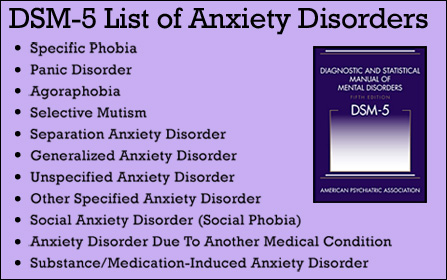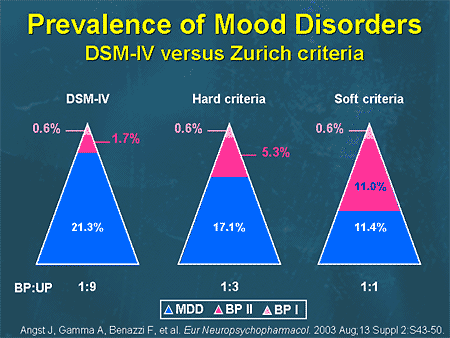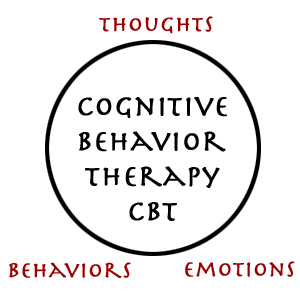What are the DSM criteria for depression? What is DSM diagnosis for depression? Known as DSM-for short, this manual will be the fifth edition of a guide that helps health professionals diagnose mental disorders , such as depression , by providing consistent criteria for each condition. As with any regularly updated book, some changes are in store for the latest edition of the DSM.

Bipolar I and II disorders. These mood disorders include mood swings that range from highs (mania) to lows ( depression ). One major area of change in the DSM-was the addition of two new depressive disorders : disruptive mood dysregulation disorder and premenstrual dysphoric disorder (PMDD). The diagnosis of disruptive mood dysregulation disorder is reserved for children between the ages of and who demonstrate persistent irritability and frequent episodes of out-of-control behavior. The individual must be experiencing five or more symptoms during the same 2-week period and at least one of the symptoms should be either (1) depressed mood or ( ) loss of interest or pleasure. Depressed mood most of the day, nearly every day.
DSM-Depressive Disorders : Diagnostic and Treatment Implications Gary G. According to the Diagnostic and Statistical Manual of Mental Disorders , the essential feature of a major depressive episode is either depressed mood or loss of interest in daily activities over a period of at least two weeks. Practice Guideline for the Treatment of Patients With Major Depressive Disorder , Third Edition 13. Each rating of clin- ical confidence considers the strength of the available ev- idence. It is categorized with Depressive Disorders and is discussed in that section. In DSM -IV, Criterion A for Manic Episode included elevate expansive and irritable mood.

In addition to elevated moo DSM - added changes in energy and activity levels. The depression DSM code from the ICD-is determined by the severity, which can be mil moderate or severe, as well as the status, like depresse in remission, or having recurrent depressive episodes. Although this is sometimes called the DSM code for depression , the code is actually from the ICD-10. Although the secondary symptoms can be divided into somatic and non-somatic clusters, the DSM - identify depression in all or none fashion.
DSM - lists the following diagnostic criteria for hoarding disorder: Persistent difficulty discarding or parting with possessions, regardless of their actual value. The difficulty is because of a perceived need to save the items and the associated distress when trying to discard them. Describes the DSM-diagnostic criteria for PTS including an overview of revisions from DSM-IV. Apply for and manage the VA benefits and services you’ve earned as a Veteran, Servicemember, or family member—like health care, disability, education, and more.
This is important because it can help you cope with future challenges and potentially avoid future bouts of situational depression. The manic episode may have been preceded by and may be followed by hypomanic or major depressive episodes. Persistent depressive disorder, also called dysthymia (dis-THIE-me-uh), is a continuous long-term (chronic) form of depression.
You may lose interest in normal daily activities, feel hopeless, lack productivity, and have low self-esteem and an overall feeling of inadequacy. PTSD is included in a new category in DSM - , Trauma- and Stressor-Related Disorders. All of the conditions included in this classification require. Firstly, a doctor may perform a physical evaluation to rule out any other conditions that may be causing symptoms. A person suffering from postpartum depression has to meet these symptoms of a major depressive episode.

Table 2: Lifetime prevalence rates of persistent forms of depression in the general population. Since the classic descriptions, depression has been conceived as an episodic and recurrent illness. However, the subtyplng of depression Is fundamental for Its correct treatment. The current subtyplng of depression Is based on Diagnostic and Statistical Manual of Mental Disorders, 4th eText Revision ( DSM -IV-TR) criteria. The major depressive episode is the basic definition of depression given in DSM -IV-TR.
The Association Between Depressive Disorder and Chronic Pain Chronic pain and depression often go hand in hand. The prevalence of pain symptoms in patients with depression ranges from to 1 while the prevalence for concurrent major depression in patients identified as having pain ranged from to. In many respects depression symptoms according to the DSM - are similar to the ICD-depression symptoms. The changes in the brain and the changes in the body complicate treatment for major depression when double depression occurs.

Another problem caused by the underlying, long-term depressed mood is that people with dysthymia tend to be more likely to abuse tobacco, alcohol, or street drugs or maintain an unhealthy diet. Severity of depression according tot he DSM -IV. The severity of a depression can be decided with the help of the amount of symptoms present.
The more symptoms are present, the more severe the depression is. The DSM -IV has the following criteria for this: If one criterion is met, “symptom depression ” is indicated.
No comments:
Post a Comment
Note: Only a member of this blog may post a comment.